Schools of Arts
Introduction
This post highlights five Schools of Arts along the Queensland Coast, in particular those with heritage buildings.
For a six week period across May and June we drove north along the Queensland coast from Maroochydore to Cairns and back – a total of 4735 Kilometres. We are planning an eBook about the trip to be published before the end of the year. In the meantime though I want to prepare a few posts sharing some interesting observations from the trip. This is the first such post.
The focus for the trip was Queensland Heritage Buildings and during the research we noted that many Queensland towns had a School of Arts. This blog shares a little history of Schools of Art in general and photos of five Schools of Arts in Maryborough, Bundaberg, Rockhampton, Townsville and Cairns.
The post describes the architecture, origins, function, challenges and current status of School of Arts before considering the characteristics of each school.
Architecture
Four of the Schools of Arts shown here were designed during the last 15 years of the 19th Century and one in the early part of the 20th Century:
- Maryborough – 1887-88; Classicism
- Bundaberg – 1888-89; Classicism – classical revival style
- Townsville – 1891; Classicism
- Rockhampton – 1894; Classicism
- Cairns – 1907; Classicism
The Queensland Heritage Register classifies all these buildings as having a style of “Classicism” with specific reference to Bundaberg’s School as “classical revival”. So what is the “Classicism” style? I am not a specialist in architectural styles but my research suggests that classicism:
- began with ancient Greeks and was developed and elaborated by the Romans
- buildings are unmistakably symmetrical (e.g. windows and columns are spaced equally usually either side of the entrance)
- features may include: arches, columns, porticos, triangular pediments and decorations etc.
- conveys a sense of strength and importance
- Is the core of the Victorian (1840-1890) and Federation (1890-1915) eras of architecture in Australia.
My personal feeling is that these buildings are anchored in the Victorian Free Classical style. They were erected in a boom time in Queensland. Government buildings were required to have that sense of strength and importance, however they needed to be erected pretty quickly, acknowledge the climate (tropical/sub-tropical), and adhere to a budget. In addition, the reasonable assumption could be made that specialist building skills were scarce (especially in building true classical style).
So all these buildings are characterized by:
- a symmetrical appearance.
- Loggias (external corridors with columns and arches), except the Cairns building which has verandahs. These acknowledge the tropical/sub-tropical weather by providing respite from the sun and rain.
- ornate decorative elements on the façade (except the building in Townsville perhaps).
- pediments (Maryborough, Bundaberg and Rockhampton)
I haven’t been able to find a reference which clearly defines the differences between the various styles.
Origins
The Australian Schools of Arts were modelled on the British Mechanics’ Institute. The first institute was established in London in 1824 to improve the education of working men by instructing them in various trades. These institutes became popular and soon became a movement. Across the 19th century their role broadened to deliver adult education in general. The concept was soon adopted throughout the British Empire during the 19th century.
The first School of Arts in Queensland was established in Brisbane in 1849 to provide services to the community in literary, philosophic and scientific subjects. Once again their popularity grew and by the late 1890s some 350 schools were established across Queensland. The “Arts” in School of Arts should be considered as manual arts or practical skill training.
Function
Quite clearly the Schools of Arts in Queensland adopted a broader approach to community education and social development. For the first School of Arts committee in Queensland, established in Brisbane in 1849, the aim was ‘the advancement of the community in literary, philosophic and scientific subjects’. Across time these schools were highly valued as adult education providers and as venues for social activities within the community . The government made land available, assisted with building costs and the purchase of books. Renting of the school facilities to the community was also an important source of revenue.
Key functions of Schools of Arts included:
- Technical classes (part of the education charter of a school) until 1908 when the function was taken over by a Technical College Committee.
- Library services (albeit by subscription) until the 1970s. In the late 19th century books were scarce and expensive so this service was highly valued by the aspiring and rising middle classes.
- Adult education activities.
- Providing a venue for community activities (e.g. room rental)
Current Status
Schools of Arts played an important role in the community from the mid-19th century to almost the mid-20th century. However, the services they provided are now by enlarge delivered through the state government or local councils. For example, as the cities have grown the technical classes have been taken over by state government departments, and libraries taken over by local councils. This has meant different purpose built premises are used.
The Schools of Arts buildings, assets and liabilities have been taken over by the local councils. Nevertheless these buildings are used by local councils to provide social services either by themselves or rental of the facilities.
Challenges
The Schools of Arts movement faced many challenges:
- The Queensland Government became responsible for technical education in 1908. So it wasn’t long before technical education was conducted elsewhere.
- Financial support was withdrawn during the depression years which made it difficult for many schools to survive.
- The Libraries Act of 1943 which provided for free libraries in Queensland caused many schools to close. Library lending was an important source of funding for many schools.
- The need to relocate, extend and maintain buildings during the early years of growth and independence.
============================================
Going to Queensland?
 Our eBook: Queensland Coastal Towns – A Road Trip can be found on:
Our eBook: Queensland Coastal Towns – A Road Trip can be found on:
Amazon (Kindle US), Amazon (Kindle UK), Amazon (Kindle AU)
Smashwords (EPUB), Smashwords also distributes to Oyster, Scribd, Yuzu, Blio and Inktera (formerly Page Foundry) and reaches OverDrive (world’s largest library ebook platform serving 20,000+ libraries), Baker & Taylor Axis 360, Gardners (Askews & Holts and Browns Books for Students), and Odilo (2,100 public libraries in North America, South America and Europe), Kobo, Apple iTunes and Barnes and Noble
============================================
Individual Schools of Arts
Clicking on the images below will enlarge them.
Gympie School of Arts
Key Characteristics of Gympie School of Arts:
- The Gympie School of Arts was first established in 1870. A city mayor and businessman named Edward Bytheway was the driving force behind the initiative. A rental property, providing a temporary reading room, was used until 1874 before a hall was built on government-gifted land.
- The current building, designed by Hugo W Durietz, was constructed between 1904 and 1905. The building was funded by the savings and the sale of an earlier building and land and cost £
- The no-frills design of the building provided for: a ground floor with a central entrance leading to a library and four classrooms; and an upper floor comprising two rooms – one specially reinforced to take billiard tables and the other a reading room across the front of the building. The building, built from brick, had two storeys with verandahs across the front and half-way down each side of the top floor (see photograph).
- The building opened as the School of Arts and Technical College in 1905. Practical classes were conducted in the building. The operation of the School was funded by member subscriptions. Across the 1920s and 1930s social changes in the community, the depression, and world wars meant that the School lost members and struggled financially. The financial situation was such that the top floor was converted into a flat for rental.
- Other changes which lead to the demise of the School included: the government’s free library system, the establishment of TAFE in the 1970s, and the Gympie Adult Education organisation. Eventually, in 1975 the building was refurbished to house the free municipal library. This led to the resignation of the School of Arts trustees, with the building and library being managed by the Gympie Council.
- At various times the building housed the Wide Bay Regional Council, Police Department and National Fitness Council in addition to the library. In 1995 the library moved to new premises leaving the building vacant.
- The Gympie Regional Gallery currently occupies the council building. It first moved to the building on the 28 February 2003.
- The Gallery has three contemporary display spaces (Gympie Times exhibition space, Hugo Du Du Rietz Gallery, and Gallery 3), plenty of storage space, a Gallery Shop, and the Edward Bytheway meeting room.
- The building was Heritage Listed on the 23 April 1999.
Source
Queensland Heritage Register – https://apps.des.qld.gov.au/heritage-register/detail/?id=601910#
Heritage Wonders of the Gympie Region, Gympie Times, p. 27, 2017. Celebrating 150 years of Gympie 1867 – 2017.
Maryborough School of Arts
Key Characteristics of Maryborough School of Arts:
- A government grant of land and a loan enabled the first School of Arts to be constructed and opened in 1861. The School of Arts committee, which was established in 1860, envisaged technical classes would be conducted and a public library provided.
- The current building was constructed 1887-88. This building has undergone a number of changes. An additional classroom was added in 1895 with a verandah extension in 1900 and a further lecture hall in 1903-4; In 1896 a verandah and loggia were added; A gallery was added to the library in 1907
- The first technical classes, funded by a grant in 1890, were in art and science and very popular. In 1910, following new state government laws in 1908, the management of the technical classes transferred to the Maryborough Technical College. The classes were removed from the School of Arts in 1938.
- Following the loss of technical classes and the reduced finding support during the depression years the School of Arts had many different tenants utilising the facilities (e.g. The Country Women’s Association, RAAF Servicemen’s club during the war, the ABC, and the Post Master General’s Department).
- In 1972 the Maryborough City Council accepted trusteeship of the School of Arts land and buildings and responsibility of any financial liabilities.
- The library remained within the School of Arts until 1977 when the Maryborough Public Library was opened. This was despite the new Library Act of 1943 empowering local authorities to establish new libraries.
- In 1977 the Maryborough Wide Bay and Burnett Historical Society remained in the building as tenants with a 40 year lease.
Source
Queensland Heritage Register – https://environment.ehp.qld.gov.au/heritage-register/detail/?id=600701
Bundaberg School of Arts
Key characteristics of Bundaberg’s School of Arts:
- The site of Bundaberg was officially surveyed in 1869. Land was reserved for a School of Arts in 1871. A modest timber School of Arts opened a short time later. The population of Bundaberg was 100 at the time. The current building was constructed in 1888-89.
- Membership was by subscription and numbers were low; Volunteers operated the school.
- It had a library (1400 volumes) which was popular (extended in 1920s) until the Libraries Act of 1943 provided free lending libraries. The school’s excellent library was the only library in Bundaberg until the 1970s. The library moved out of the school in 1981.
- From the outset it had a natural history museum. After the Second World War its collection was broken up.
- The school was successful in running practical classes (e.g. drawing, shorthand, bookkeeping, typing, dressmaking, millinery, chemistry, dairy work and carpentry) from 1889 until 1908 when the responsibility for technical education was shifted to the government. The school continued to operate during the depression when government subsidies to Schools of Arts ceased.
- The land, building and assets were transferred from the school’s trustees to the Bundaberg city council in 1979.
- The Bundaberg and district Museum was formed in 1970 and moved into the hall. The museum moved out into a new building in 1988.
- From the 1980s until the late 1990s the Bundaberg Art Society used the school as an art gallery and offices.
- Today the community can hire the building for cultural and other community purposes.
Source
Queensland Heritage Register – https://environment.ehp.qld.gov.au/heritage-register/detail/?id=600362#tab-history
Rockhampton
Key characteristics of Rockhampton School of Arts:
- The first School of Arts building was opened in 1865 and membership grew from 40 to 380 in 1890 and its library grew from 250 to 7000 volumes in the first 15 years (1865-1890). A museum and library wing was added in 1872.
- The initial building had to be replaced in 1894 at a cost of GBP 5,578 (most expensive in the colony). It was a substantial masonry structure similar only to the schools at Maryborough and Bundaberg (This is part of the building’s significance today).
- The Rockhampton School of Arts held the first meeting for the “Queensland Separation Movement” to agitate for a new state centred on Rockhampton in the period prior to federation.
- The new building contained a hall for 800 patrons. In 1909 a curved dress circle was added to the second floor of the hall to extend capacity from 800 to 1500 patrons. In the 1920s the hall was licensed as a place of “public amusement and entertainment”.
- A residence for the secretary-librarian was also constructed pointing to the significance of the school.
- The new building also contained a library (with over 11,000 books), a museum, and in 1903 a recreation room, chess and card room were added. The recreation rooms were replaced with a new building housing an immunisation clinic, club rooms for Rockhampton Little Theatre and a caretakers flat in 1976.
- Between 1904 and 1906 a School of Mines was added to the complex but it soon closed through a lack of interest. A child care centre now stands on the site of the School of Mines.
- Technical classes undertaken by the School of Arts were taken over by the Department of Public Instruction in 1908.
- The building continues to provide facilities for the community, even though the traditional functions of the technical classes, library and museum have moved.
Source
Queensland Heritage Register: https://environment.ehp.qld.gov.au/heritage-register/detail/?id=600788.
Townsville
Key characteristics of the Townsville School of Arts:
- Townsville was established in 1864, gazetted as a port in 1865 and in 1866 the first School of Arts committee was established. The School of Arts started in a rented property (with 30 books), moved to its own home in 1877, and moved to its final building in 1891.
- The new building had meeting rooms and classrooms on the ground floor and a large library above. Initial classes included drawing, singing and woodwork. The first gas-cooking classes in Townsville were held here in 1895. A 600 seat theatre (originally called “Her Majesty’s”) was connected to the building. Notable appearances included Dame Nellie Melba (1909), a Chinese Opera company (1894), and the first aboriginal stage performance in Townsville (1907).
- The building suffered cyclone damage in 1896 (Sigma) and 1903 (Leonta) with repairs undertaken in 1904. The auditorium was extended in 1913. It underwent extensive renovation in 1976 and further works in the 1990s when the verandah was reinstated.
- The committee could foresee the impact of the government’s Library Act and the Trustees resigned. In 1938 the assets were vested in the Townsville City Council as Trustee. This created the first free public lending library in Australia.
- Between 1941 and 1976 the building had a number of tenants including the RAAF (as a postal office), Townsville Regional Electricity Board, and the Northern Electricity Authority.
- It is currently the home of the North Queensland Ballet and Dance Company (Dance North)
Source
Queensland Heritage Register: https://environment.ehp.qld.gov.au/heritage-register/detail/?id=600925.
Cairns
Key characteristics of the Cairns School of Arts:
- The School of Arts building shown above was built in 1907. The School of Arts was established in 1885 and its first timber building constructed in 1886. In response to demand a larger two-storeyed building was constructed in 1907. The top floor for the School of Arts and the ground floor for revenue producing rental shops. The building was extended in 1932 to provide more shop space for rental. Shop fronts were modernised in 1935. Further renovations were conducted in 1939-41 and around 1983.
- Technical classes were commenced at the School of Arts but the Department of Public Instruction took them over in 1911.
- The School of Arts operated the only library in Cairns up until 1977 when the building and library were transferred to the Cairns City Council.
- In 1980 the Cairns Historical Society opened a museum on the top floor. The museum still operates today with shops on the ground floor.
Source
Queensland Heritage Register: https://environment.ehp.qld.gov.au/heritage-register/detail/?id=600380.
References
The material above is drawn largely from the “History” section of each School of Art as listed in the Queensland Heritage Register. For example: (1) Visit the heritage website at https://environment.ehp.qld.gov.au/heritage-register/; (2) Enter the name of the School of Arts, for example – Rockhampton School of Arts and click “Search Places”; (3) Once the search result is displayed, click on the school name; (4) Once you have reached the school page, click on the “History” Tab.
- A History of Mechanics’ Institute Libraries: http://mechanicsinstitutes.blogspot.com.au/
- http://sydneyarchitecture.com/STYLES/search-style.htm
Return to other travel destination articles
Return to all of our travel articles
Visits: 4761

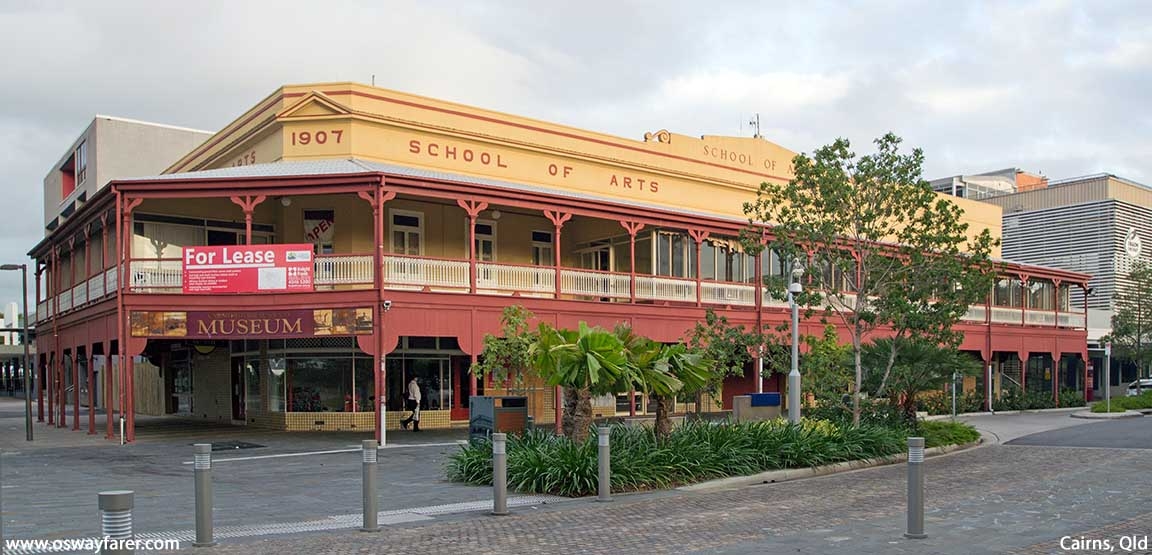


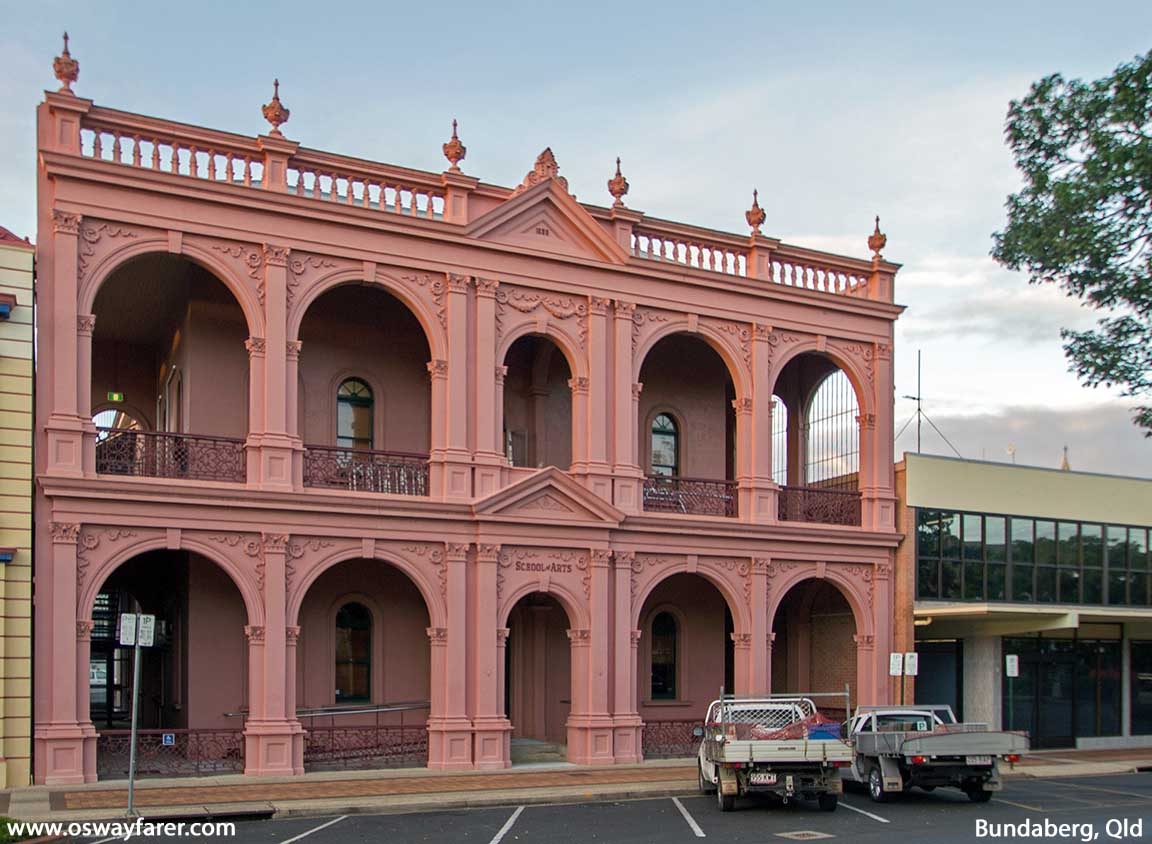
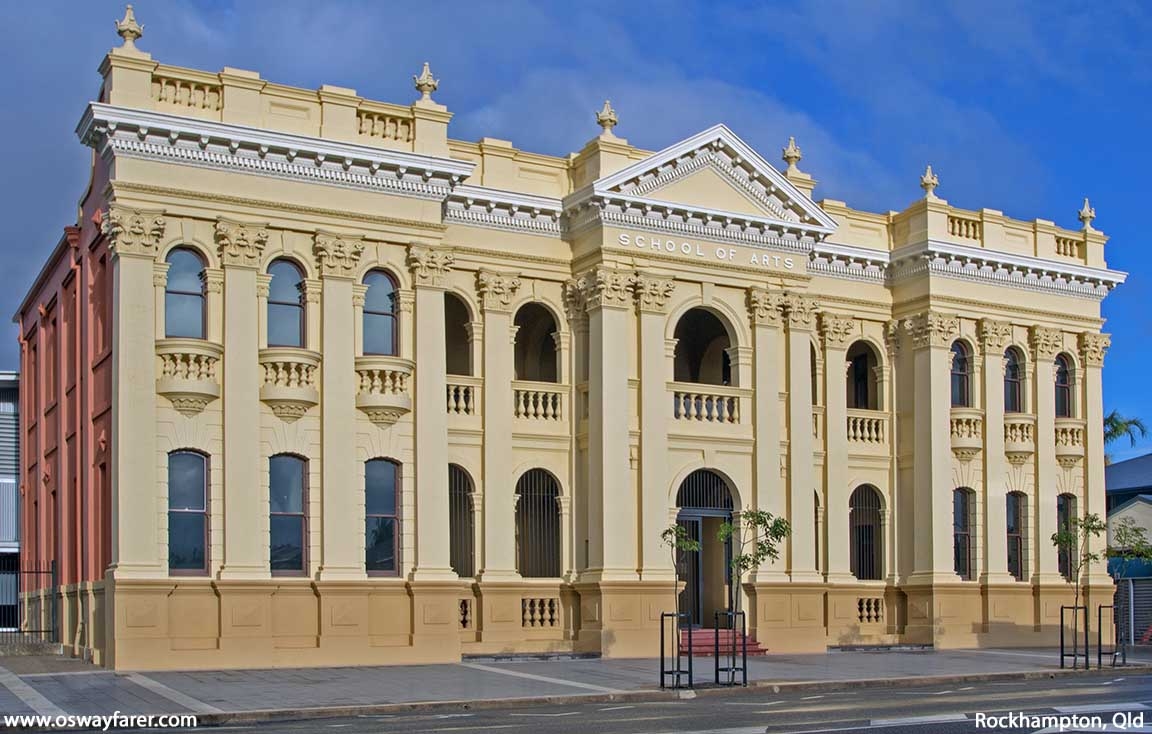
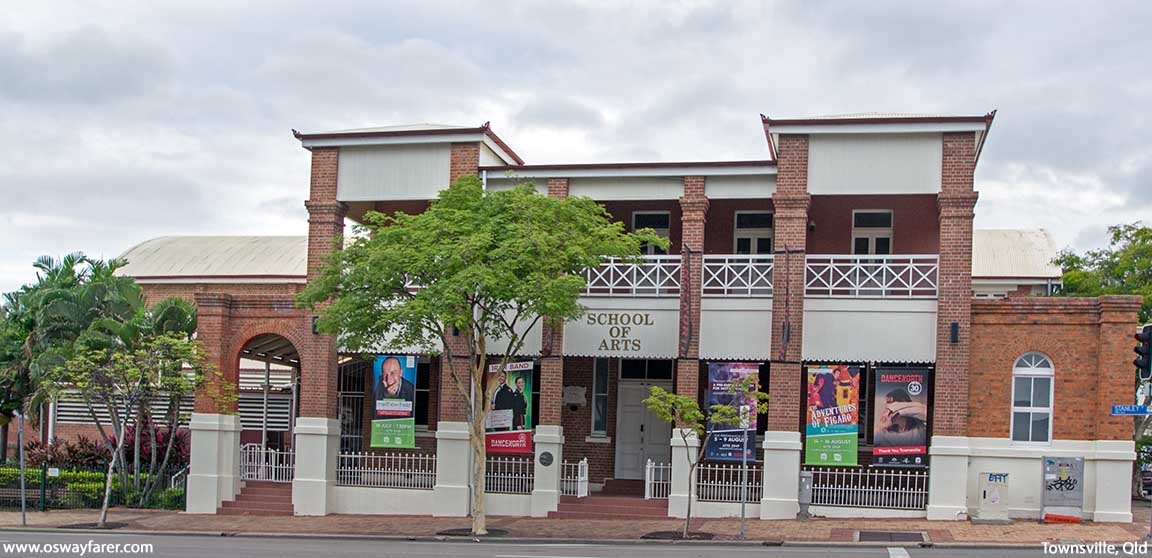

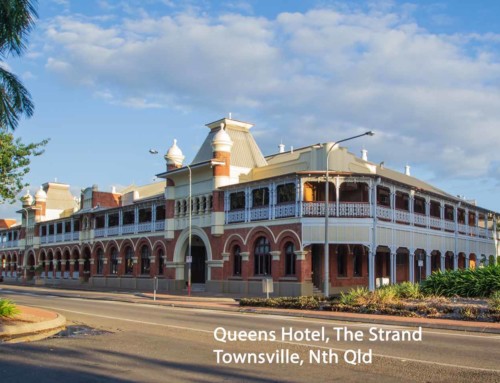
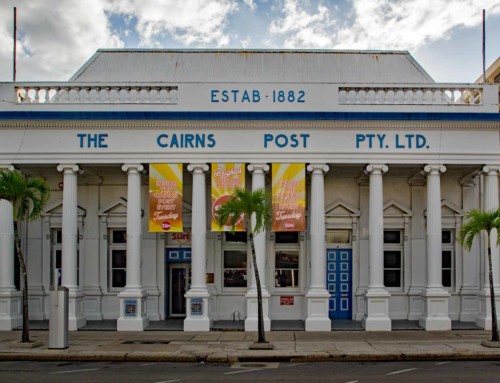
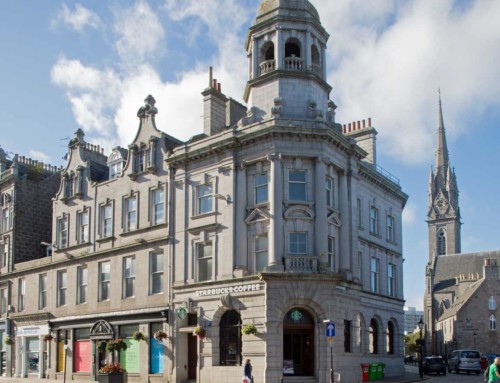
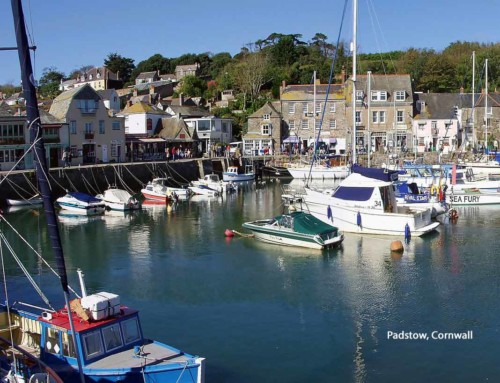
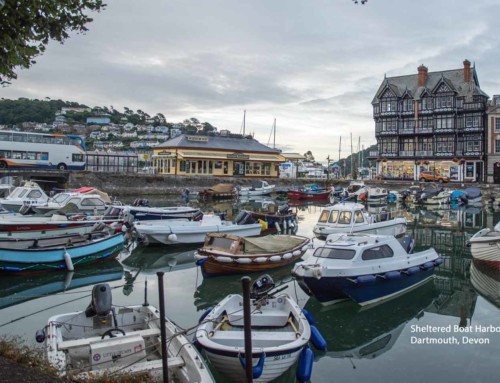

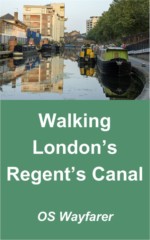
Leave A Comment